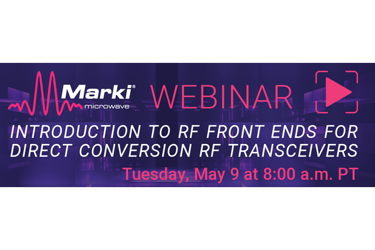Introduction To RF Front Ends For Direct Conversion RF Transceivers

There is more to a direct sampling RF front end than simply an antenna connected to a data converter, but what happens between these two components can feel like magic. How do we make a black box that takes information from the antenna, selects information of interest, and conditions the signal so it can be digitized by a data converter?
Join us for this webinar as we walk through the building blocks of a direct sampling RF front end and discuss avoiding common pitfalls and misconceptions that can occur when designing and selecting components for the RF front end.
Date: May 9, 2023
Time: 11 AM EDT (8 AM PDT / 5:00 PM CEST)
Duration: 1 hour
Overview
As the sample rate of modern data converters increases, direct sampling transceivers are quickly becoming the standard architecture for certain key applications. There are many benefits to direct sampling, however removing frequency conversion does not mean an antenna connected to a data converter will provide usable performance. To condition the input signals to a level that the data converter is optimized to work with, an RF path is required. This path can become complex when there are requirements necessary to handle multiband or multibeam communication architectures, which demand use of components that satisfy design requirements across extremely broad bandwidths.
In this webinar, we will discuss how modern direct sampling transceivers are realized in hardware from the block diagram down to component selection. Learn about the role each subsystem plays in the transceiver, their figures of merit, and what to look for at the component level of your design. If you are familiar with the data side of a transceiver but want to discover more about how the RF side works, or you are an RF engineer and just want to add some depth to your existing knowledge, come join us for this exciting and informative webinar!
Key Takeaways
- Reenforce the basics of direct conversion transceivers and their figures of merit.
- Gain the ability to articulate what sub-blocks are needed to realize a direct conversion transceiver and their functions within the transceiver.
- Understand the figures of merit for each sub-block and how they affect transceiver performance.
- Learn how to select the ideal components to build each sub-block and identify which figures of merit are important at the component level.
Speaker: Harley Berman, Applications Engineer, Marki Microwave
Since joining the company in 2019, Berman’s role has spanned working with mixers, multipliers, limiters, and passive devices, to conducting experiments for tech notes, datasheet characterization and applications support. Berman has contributed to the release of products across most of Marki Microwave’s product families, published seven tech notes on various products and system considerations, and hosted webinars on mixer spurs and the performance of Marki Microwave hardware in quantum information systems. Prior to joining Marki Microwave, he was a student at University of California, Santa Cruz where he obtained a bachelor’s degree in electrical engineering, graduating with highest honors. While at the university, he contributed to the RF payload for the school's 2U cubesat project, SlugSat.
